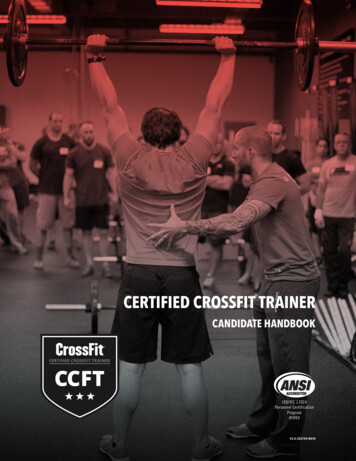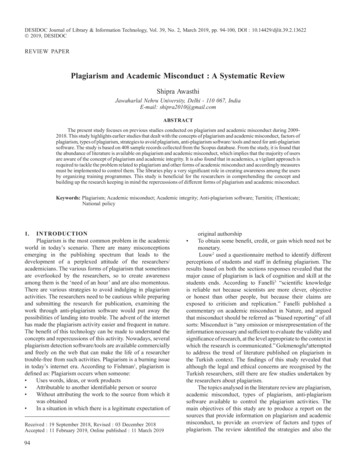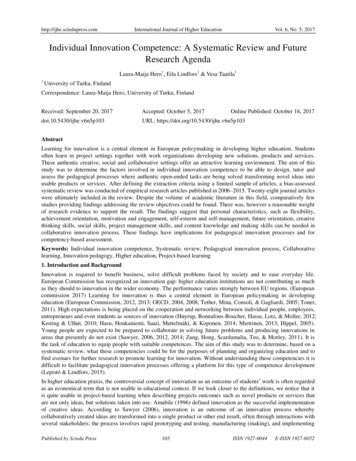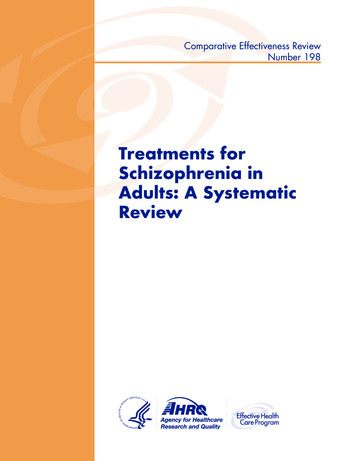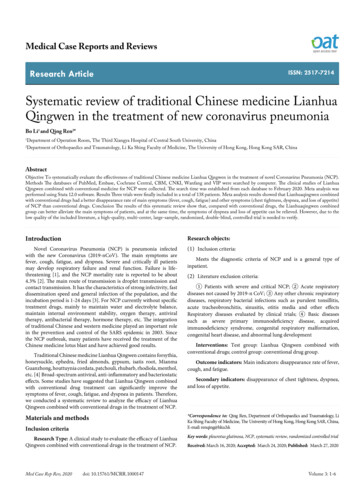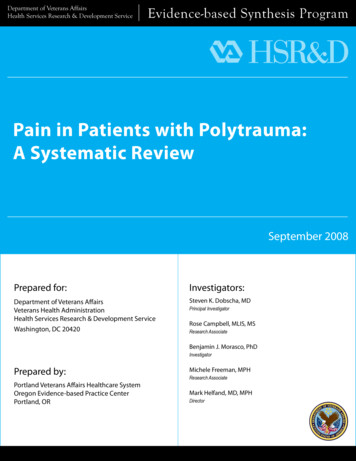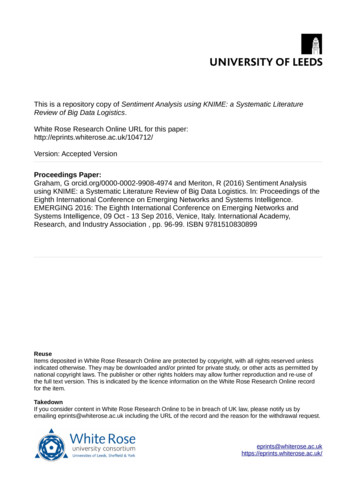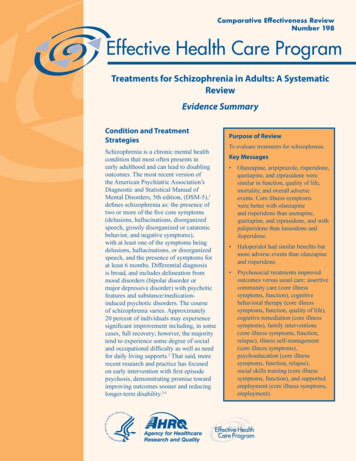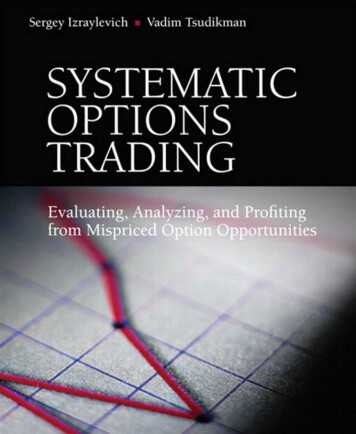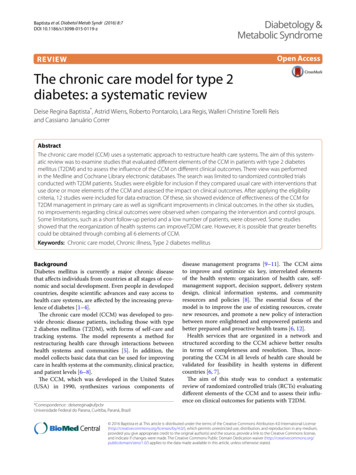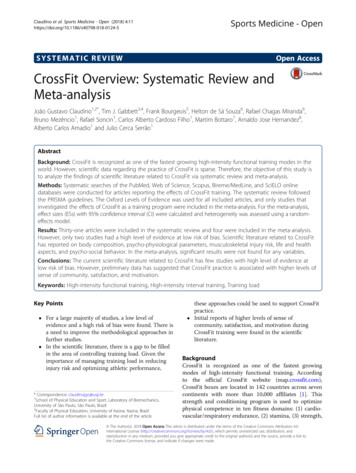
Transcription
Claudino et al. Sports Medicine - Open (2018) MATIC REVIEWOpen AccessCrossFit Overview: Systematic Review andMeta-analysisJoão Gustavo Claudino1,2*, Tim J. Gabbett3,4, Frank Bourgeois5, Helton de Sá Souza6, Rafael Chagas Miranda6,Bruno Mezêncio1, Rafael Soncin1, Carlos Alberto Cardoso Filho1, Martim Bottaro7, Arnaldo Jose Hernandez8,Alberto Carlos Amadio1 and Julio Cerca Serrão1AbstractBackground: CrossFit is recognized as one of the fastest growing high-intensity functional training modes in theworld. However, scientific data regarding the practice of CrossFit is sparse. Therefore, the objective of this study isto analyze the findings of scientific literature related to CrossFit via systematic review and meta-analysis.Methods: Systematic searches of the PubMed, Web of Science, Scopus, Bireme/MedLine, and SciELO onlinedatabases were conducted for articles reporting the effects of CrossFit training. The systematic review followedthe PRISMA guidelines. The Oxford Levels of Evidence was used for all included articles, and only studies thatinvestigated the effects of CrossFit as a training program were included in the meta-analysis. For the meta-analysis,effect sizes (ESs) with 95% confidence interval (CI) were calculated and heterogeneity was assessed using a randomeffects model.Results: Thirty-one articles were included in the systematic review and four were included in the meta-analysis.However, only two studies had a high level of evidence at low risk of bias. Scientific literature related to CrossFithas reported on body composition, psycho-physiological parameters, musculoskeletal injury risk, life and healthaspects, and psycho-social behavior. In the meta-analysis, significant results were not found for any variables.Conclusions: The current scientific literature related to CrossFit has few studies with high level of evidence atlow risk of bias. However, preliminary data has suggested that CrossFit practice is associated with higher levels ofsense of community, satisfaction, and motivation.Keywords: High-intensity functional training, High-intensity interval training, Training loadKey Points For a large majority of studies, a low level ofevidence and a high risk of bias were found. There isa need to improve the methodological approaches infurther studies. In the scientific literature, there is a gap to be filledin the area of controlling training load. Given theimportance of managing training load in reducinginjury risk and optimizing athletic performance,* Correspondence: claudinojgo@usp.br1School of Physical Education and Sport, Laboratory of Biomechanics,University of São Paulo, São Paulo, Brazil2Faculty of Physical Education, University of Itaúna, Itaúna, BrazilFull list of author information is available at the end of the articlethese approaches could be used to support CrossFitpractice. Initial reports of higher levels of sense ofcommunity, satisfaction, and motivation duringCrossFit training were found in the scientificliterature.BackgroundCrossFit is recognized as one of the fastest growingmodes of high-intensity functional training. Accordingto the official CrossFit website (map.crossfit.com),CrossFit boxes are located in 142 countries across sevencontinents with more than 10,000 affiliates [1]. Thisstrength and conditioning program is used to optimizephysical competence in ten fitness domains: (1) cardiovascular/respiratory endurance, (2) stamina, (3) strength, The Author(s). 2018 Open Access This article is distributed under the terms of the Creative Commons Attribution 4.0International License (http://creativecommons.org/licenses/by/4.0/), which permits unrestricted use, distribution, andreproduction in any medium, provided you give appropriate credit to the original author(s) and the source, provide a link tothe Creative Commons license, and indicate if changes were made.
Claudino et al. Sports Medicine - Open (2018) 4:11(4) flexibility, (5) power, (6) speed, (7) coordination, (8)agility, (9) balance, and (10) accuracy [2]. CrossFittraining is usually performed with high-intensity,functional movements called “workout of the day”(WOD) [3]. In these training sessions, high-intensityexercises are executed quickly, repetitively, and withlittle or no recovery time between sets [4]. With thefocus on constantly varying functional movements,CrossFit training uses the main elements of gymnastics(e.g., handstand and ring exercises), weightlifting exercises (e.g., barbell squats and presses), and cardiovascular activities (e.g., running or rowing) as exercise tasks[5]. According to Glassman, who is the founder ofCrossFit, the methodology that drives CrossFit trainingis entirely empirical. Furthermore, Glassman describedthat “meaningful statements about safety, efficacy, andefficiency, the three most important and interdependentfacets of any fitness program, can be supported only bymeasurable, observable, repeatable facts, i.e., data” [3].CrossFit is also considered an option for high-intensityinterval training (HIIT). Consequently, HIIT has becomeone of the top 3 worldwide fitness trends since 2013according to the American College Sports Medicine(ACSM) annual survey [6–9]. Notably, CrossFit was indicated as the primary reason HIIT workouts were rankedso high [6–9]. However, a consensus paper produced bythe Consortium for Health and Military Performance(CHAMP) and ACSM associated a potential emergence ofa high injury risk with programs such as CrossFit [10].While positive influences on body composition andphysical fitness were recognized, the consensushighlighted a “disproportionate musculoskeletal injury riskfrom these demanding programs, particularly for noviceparticipants, resulting in lost duty time, medical treatmentand extensive rehabilitation”. In addition, the consensussuggested the existence of a training paradigm requiringadvanced level technique during maximal timed exerciserepetitions without adequate rest intervals between sets,as well as an insufficient recovery time between high-volume loads and training sessions. This overload situationcan lead to early fatigue, additional oxidative stress, lessresistance to subsequent repetitive exercise strain, greaterperception of effort, and unsafe movement execution [10].Furthermore, this training context associated with inadequate training load progression increases the risk of overuse injury, overreaching, and overtraining. The consensusauthors suggested, as a possible solution, individual monitoring of training load to minimize these risks [10]. Despite the proposed risks of CrossFit, others have suggestedthat high-intensity functional training programs, includingCrossFit, have similar or lower potential for injury thanmany traditional physical training activities [11]. However,the authors also stated that controlling training volumemust be done in order to reduce injury risk in militaryPage 2 of 14populations. For an effective training process and adaptation to occur, the monitoring [12], quantification [13], andregulation [14] of training load is necessary. However,managing training load poses a considerable challenge forsport scientists [15, 16]. Despite this challenge, managingtraining load is fundamental to achieving the objectives ofreducing injury risk and optimizing sports performance[17–22].Although there are a large number of CrossFit participants, empirical evidence demonstrating the improvementsin physical fitness that arise from this form of training arefar from substantive. Furthermore, an overview ofCrossFit’s outcomes has not been verified. Therefore, thepurpose of the present study was to analyze the findings ofthe scientific literature related to CrossFit through asystematic review and meta-analysis.MethodsLiterature SearchOne author conducted the literature search, collatedthe abstracts, and applied the initial inclusion criteria. The keyword “CrossFit” was used during theelectronic search. The following electronic databaseswere searched on the 25th of November 2016:PubMed, Web of Science, Scopus, Bireme/MedLine,and SciELO (Fig. 1). The Preferred Reporting Itemsfor Systematic Reviews and Meta-Analyses (PRISMA)reporting guidelines were adhered to in this manuscript.In the initial analysis, all CrossFit articles included inthis manuscript were peer-reviewed and not limitedto specific years or language. During the secondphase of study selection, two authors reviewed andidentified the titles and abstracts based on the inclusion criteria.Inclusion CriteriaTo meet the inclusion criteria for the meta-analysis,studies investigating humans “in vivo” or “in obitus” andanalyzed the effects of CrossFit as a training programwere considered. The meta-analysis was only conductedon variables from short-term intervention studies (i.e., 3 weeks) with healthy male and/or female participantssplit into distinct gender groups (the procedures wereconsistent from those of another meta-analysis) [23].Moreover, the variables analyzed were to be found inmore than one study. If pertinent data were absent,authors were contacted and the necessary informationrequested via e-mail. If the original data were not provided by the authors, the mean and standard deviationswere extracted from graphical representation usingYcasd [24] or estimated from the median, range, andsample size [25]. The remaining articles were includedin the systematic review.
Claudino et al. Sports Medicine - Open (2018) 4:11Page 3 of 14Fig. 1 Study selection PRISMA flow diagramStudy QualityThe Consolidated Standards of Reporting Trials (CONSORT) statement was adapted and used for checking thequality of reporting by two authors independently. Thus,the articles’ quality was evaluated based on the 25 itemsidentified in the CONSORT criteria, providing a maximalpossible score of 37. The CONSORT items are distributedin sections and topics such as “Title and abstract”;“Introduction” (Background and objectives); “Methods”(Trial design, Participants, Interventions, Outcomes,Sample size, Blinding, Statistical methods); “Results”(Participant flow, Recruitment, Baseline data, Numbersanalyzed, Outcomes and estimation, Ancillary analyses,Harms); “Discussion” (Limitations, Generalizability,Interpretation); and “Other information” (Registration,Protocol, Funding) [26]. Additionally, the Oxford Levels ofEvidence [27] were used to evaluate the level of evidencefor all articles found in the literature on CrossFit. Wherethe five levels (i.e., Level 1 systematic reviews; Level 2 randomized controlled trials with low/moderate risk ofbias or observational studies with dramatic effect; Level 3 cohort study, non-randomized controlled trials withlow/moderate risk of bias or randomized controlled trialat high risk of bias; Level 4 case series, case report,case-control studies, cohort study, historically controlledstudies or non-randomized controlled trials at high risk ofbias; and Level 5 mechanism-based reasoning/expertopinion) are determined based on the following questions:(i) “How common is the problem?”; (ii) “Is this diagnosticor monitoring test accurate? (diagnosis)”; (iii) “What willhappen if we do not add a therapy? (prognosis)”; (iv)“Does this intervention help? (treatment benefits)”; (v)“What are the COMMON harms? (treatment harms)”;(vi) “What are the RARE harms? (treatment harms)”; and(vii) “Is this (early detection) test worthwhile? (screening)”.Bias AnalysisFor the systematic review, two authors independentlyassessed the quality of the included studies using theCochrane risk of bias tool [28] with a priori formulatedcriteria adopted from the studies of Pas et al. [29] andWinters et al. [30]. Five domains of bias were appraised:selection bias (random allocation and allocation concealment), performance bias (blinding of personnel and participants), detection bias (blinding of outcome assessment),attrition bias (loss to follow-up), reporting bias (outcomereporting), and other biases. Each item was scored as low( ), high ( ), or unclear (?) risk of bias. Studies wereconsidered low risk of bias when all domains were scoredas low risk of bias or if one item was scored as high risk orunable to determine. If two domains were scored as highor unable to determine risk of bias, the study received amoderate risk of bias. Finally, when more than twodomains were scored as high risk of bias, the study wasregarded to possess a high risk of bias. In case of disagreement between authors, consensus was sought during aconsensus meeting. If no consensus was reached, a thirdauthor was asked to provide a final verdict. Publication bias
Claudino et al. Sports Medicine - Open (2018) 4:11Page 4 of 14Fig. 2 Risk of bias and level of evidenceAllocation concealment(selection bias)Blinding of participants andpersonnel (performance bias)Blinding of outcomeassessment (detection bias)Incomplete outcome data(attrition bias)Selective reporting (reportingbias)Other bias2013 Hak [34]2013 Joondeph [35]2014 Alexandrino [37]2014 Heinrich [38]2014 Larsen [39]2014 Partridge [40]2014 Weisenthal [41]2015 Bellar [42]2015 Butcher [43]2015 Fernandez [44]2015 Friedman [45]2015 Heinrich [46]2015 Kliszczewicz [47]2015 Lu [48]2015 Martinez [49]2015 Murawska [50]2015 Shaw [51]2016 Eather a [53]2016 Eather b [54]2016 Fisher [55]2016 Fisker [5]2016 Koteles [56]2016 Lichtenstein [57]2016 Middlekauff [58]2016 Perciavalle [59]2016 Pickett [60]2016 Sprey [4]2016 Summitt [61]2016 Tibana [62]2016 Whiteman [63]2017 Drum [52]Random sequence generation(selection bias)For the meta-analysis, the heterogeneity of the includedstudies was evaluated by examining forest plots, confidenceintervals (CI), and I2. I2 values of 25, 50, and 75 indicatedlow, moderate, and high heterogeneity, respectively [31].Random effects were analyzed using the DerSimonian andLaird [32] approach. The meta-analysis was conductedbased on the number of variables from short-term intervention studies. Statistical significance was set at p 0.05
to the official CrossFit website (map.crossfit.com), CrossFit boxes are located in 142 countries across seven continents with more than 10,000 affiliates [1]. This strength and conditioning program is used to optimize physical competence in ten fitness domains: (1) cardio-vascular/respiratory endurance, (2) stamina, (3) strength,
